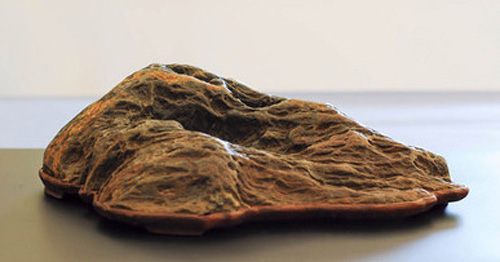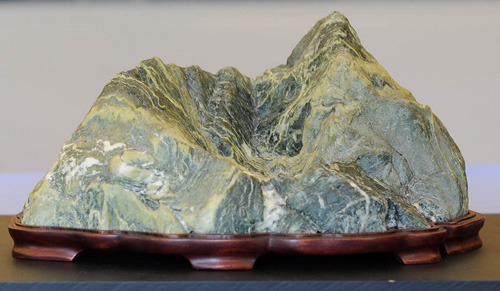
This stone speaks of Death Valley or some remote spot on the edge of the North African desert. It”s from the California Suiseki Society’s 15th Annual Show, via Bonsai Tonight.
A great debate?
I don’t think we’ve ever featured suiseki (viewing stones) on this blog. We used to feature them regularly in Bonsai Today, with occasional objections by some readers. I’ve always felt that suiseki is a natural with bonsai, so mixing in a few makes sense to me. Perhaps this is a Japanese influenced view, as it seems that you see suiseki and bonsai together with much greater frequency in Japan than in the West. Maybe this post will start a great debate on the subject (though I won’t hold my breath).

This still-in-training Satsuki azalea is also from Bonsai Tonight. It’s from The Bay Area Satsuki Aikokai’s 16th annual exhibit

Another suiseki from the California Suiseki Society’s 15th Annual Show, via Bonsai Tonight.
Two books on suiseki
Melba Tucker’s Suiseki and Viewing Stones shows some wonderful American suiseki. Willi Benz’s Bonsai, Kusamono and Suiseki, goes into the subject in great detail, with an emphasis on the relationship with bonsai and kusamono (herbaceous plants in bonsai containers), as you might expect from the title.
Hi Wayne,
in the “Land Down Under” we have in the past few years been including in the exhibitions accompanying our Australian National Bonsai conventions small displays of suiseki. Since my trip to Taiwan on the BCI 2004 Convention and Tour I have been hooked (or should that be ‘stoned’) on suiseki. In my bonsai club I am one of only a few people with a real interest in suiseki and in recent years I have been using a suiseki as a companion with some of my bonsai trees in displays. At our club’s annual exhibition I often mount a collection of various stones (usually in a themed presentation). We have found that this additional display is favorably commented upon by members of the public visiting the exhibitions. Any complementary art form that can enhance the overall enjoyment of a bonsai display is of benefit in opening up bonsai to a wider audience.
You may be interested to know that on the program for the 2011 Australian National Bonsai Convention there will be a demonstration of ‘bonseki’ – now that should set the dogs running and tongues wagging amongst the strict bonsai crowd.
So in the great debate my vote goes to inclusion of suiseki and any other complementary art form in the enjoyment of bonsai. For those whose appetite has been whetted have a look at the newsletter of the Californian Aiseki kai ( aisekikai.com ) – there are some interesting articles and photos there.
regards (and hope I’ve stirred the pot)
Frank Kelly
(member Canberra Bonsai Society & Suiseki Australia)
Thanks Frank. Stoned on stones!